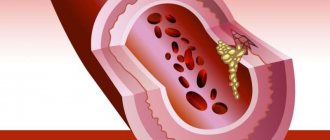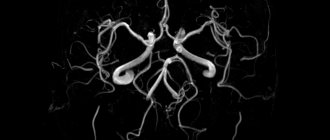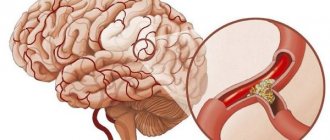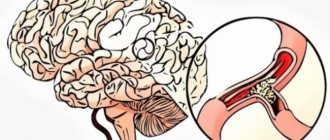If the intrauterine development of the arteries is disrupted, various variants of the structure of the arterial circle of the brain may arise. Hypoplasia is the insufficient development of a vessel with a decrease in its lumen and thin walls. These anomalies may be asymptomatic, since paired or adjacent arteries take on additional load.
With increased blood pressure, a vessel aneurysm can form with subsequent rupture; cessation of blood movement occurs due to spasm, thrombosis or embolism.
Causes of development of hypoplasia of cerebral arteries
The formation of the arterial network of the brain is disrupted when a woman is exposed to external and internal damaging factors in the first months of pregnancy. The most significant are:
- viral infections - rubella, influenza, herpes cytomegaly virus and Epstein-Barr;
- diabetes;
- smoking, drug use, alcohol use;
- taking medications from the group of anticonvulsants, neuroleptics, antitumor drugs;
- contact with toxic substances;
- irradiation;
- severe pregnancy, toxicosis, threat of miscarriage.
Arterial hypoplasia leads to the formation of a thin vessel, the walls of which are characterized by reduced strength due to a reduced number of smooth muscle fibers.
As a result of the abnormal structure, the rate of blood flow to the brain cells through such an artery decreases, and the weak wall bulges under blood pressure, causing an aneurysm. When it ruptures, intracerebral hemorrhage occurs, and when it narrows due to spasm, blockage by a thrombus or embolus, an ischemic stroke is likely to develop.
We recommend reading the article about vertebral artery compression. From it you will learn about the causes of the development of pathology and its symptoms, methods of diagnosis and treatment of the cervical spine, and physiotherapeutic procedures. And here is more information about vertebrobasilar insufficiency.
Symptoms and treatment of hypoplasia of the cerebral arteries
Hypoplasia, which is found in the area of the left cerebral artery, is an underdevelopment with a violation of the structure of the cerebral arteries, also at the stage of their formation. This condition manifests itself in the form of a lack of mass or a reduction in the size of blood vessels.
The consequences are a cerebral aneurysm or stroke. That is why anomalies in the development of the left cerebral arteries are of great importance in neurosurgical and neurological practice. Changes in the structure of the cerebral arteries influence the nature, localization and severity of pathological processes during the development of stroke.
Factors that influence the occurrence of this pathology affect the fetus’s body even in the womb, which can be said about many other congenital pathologies. During the research, scientists came to the conclusion that the pathological processes that cause vascular hypoplasia may be the following:
- injuries and bruises of a pregnant woman; excessive consumption of alcohol, taking drugs, toxic chemicals and certain medications; intrauterine infections; genetic predisposition to diseases of the circulatory system.
Variants of arterial hypoplasia of the circle of Willis
At the base of the brain there is an arterial circle that closes the carotid and vertebral arteries into a single ring, providing nutrition to neurons when there is insufficient blood flow through any of the blocked vessels.
The classic structure of the Circle of Willis occurs in approximately 55% of people. Vascular anomalies can be in the form of excessive or irregular branches of arteries, congenital aneurysms, as well as hypoplasia, the absence of a vessel (aplasia). In the latter case, the circle is considered open.
Rear connecting
Insufficient development of these arterial branches is often detected by imaging of cerebral vessels. This structural anomaly can be asymptomatic, but is also sometimes the cause of ischemic strokes in young and middle-aged people. Acute cerebrovascular accident occurs with the involvement of the occipital lobes and thalamic region. Most often, a stroke leads to the formation of cavities in the brain substance - lacunar type.
Front right and left
Slight hypoplasia of the initial segments of the arteries is found in almost 75% of subjects. In this case, the right branch is often less developed than the left.
With insufficient blood supply, the opposite artery expands and, together with the anterior communicating artery, takes on an increased load. An asymmetry of cerebral blood flow occurs, it impairs the nutrition of the frontal lobes of the brain, which can manifest itself in acute or chronic changes in cerebral hemodynamics.
general information
Hypoplasia of the vertebral arteries is a congenital disease characterized by their insufficient development. The lumen of the vessel at the site of its insertion into the bone canal narrows significantly , which causes a disruption in the blood supply to the brain tissue.
The pathology can be left-sided, right-sided or bilateral , and most often the disorder concerns the right artery - according to statistics, this phenomenon is observed in every tenth person in the world.
Symptoms of brain disorders
Expert opinion
Alena Ariko
Expert in Cardiology
The presence of arterial hypoplasia is not a disease. Many people are unaware of its existence and do not experience any discomfort throughout their lives. Problems with blood supply to the brain occur under increased stress (professional sports, stress, pregnancy, childbirth), widespread atherosclerotic changes in the arteries, blockage of the lumen of the vessel, and the inflammatory process. In such situations, an imbalance occurs between the brain's need for oxygen and the possibility of additional blood supply.
Clinical symptoms of cerebral vascular hypoplasia may increase gradually. First appear:
- frequent headaches;
- dizziness;
- decreased memory and ability to concentrate;
- emotional instability;
- sleep disorders;
- low tolerance to mental stress.
A characteristic manifestation of a vascular anomaly is paroxysmal migraine-type pain. If the circle of Willis is not closed, there is underdevelopment of the posterior communicating arteries, then cephalgia is accompanied by the so-called aura. It is perceived as flashes of light, bright spots or stripes in front of the eyes, after which a severe pain attack develops.
A long-term decrease in blood flow through the arteries of the brain causes symptoms of dyscirculatory encephalopathy - constant weakness, loss of interest in the environment, decreased performance. Over time, thinking and orientation in space and time are disrupted, the psychological characteristics of the individual change, and depression increases.
With an acute cessation of blood flow, a stroke develops. It leads to decreased or absent movements in the limbs, disorders of sensitivity, speech, vision, and swallowing. The presence of aneurysmal dilation is especially dangerous when the artery is hypoplastic. Such a thin-walled formation with high blood pressure can rupture with the occurrence of subarachnoid hemorrhage, manifested by:
- disturbance of consciousness, up to coma;
- nausea, vomiting;
- one-sided paralysis;
- convulsive syndrome;
- respiratory and cardiac disorders.
Why does brain hypoplasia occur?
Hypoplasia of the brain causes problems with blood circulation in the head. This is a congenital disease that affects blood vessels in the spine. The first signs appear in middle age. In some situations, symptoms of hypoplasia develop in younger people.
Classification of the disease
Vascular diseases often affect the brain. Hypoplasia is not an exception. This term characterizes insufficient tissue development. The disorder may be congenital or acquired during life. Most often, hypoplasia of the cerebral artery appears during fetal development.
Natural blood supply is ensured thanks to the action of the Circle of Willis. It is formed from large vertebral arteries with branches in two directions. In a normal position, such vessels develop evenly. A branched artery is responsible for the blood supply to the skull. Therefore, cerebral vascular hypoplasia is divided into: bilateral, right, left.
The disease always causes problems with brain function. To eliminate this pathology, it is necessary to undergo medical procedures that can stabilize blood flow.
Right artery
Hypoplasia of the cerebral artery appears in cases of intrauterine development disorders. The disease manifests itself when the following occurs during pregnancy:
- Falls.
- Exposure to radiation.
- Exposure to ultraviolet rays.
- After visiting the sauna.
- Consumption of alcohol and tobacco products.
The patient's impairments appear in adulthood . People often suffer from the following pathologies:
- Migraines, dizziness.
- High blood pressure.
- Drowsiness.
- Psychological disorders.
- Sensitivity worsens.
To stabilize the body's condition, it is not necessary to use therapy; the lack of blood supply is gradually compensated independently. Sometimes specialists have to intervene. The patient becomes worse due to concomitant diseases.
Atherosclerosis affects the narrowing of artery walls, and blood circulation becomes worse. Patients suffer from insomnia, and meteosensitivity increases.
It is unacceptable to stabilize the patient's condition using conservative methods. Sometimes doctors prescribe vasodilator medications. In most examples, diagnostics indicate that surgery is required.
Left artery
This type of disease manifests itself when patients develop disorders of the cardiovascular system. At the first stages, pathology is difficult to detect. The disease develops over the years and does not show itself in any way. Problems with blood circulation lead to poor vascular permeability and diseases of internal organs.
Thanks to adaptation mechanisms, the signs of the disease are smoothed out. There are no difficulties in the functioning of the body.
Even with regular visits to doctors for examination, the disease cannot always be detected. Hypoplasia of the cerebral artery always appears with age. Therefore, all symptoms require attention.
Initially, pain occurs in the neck. Because other signs are absent, the disorder is difficult to diagnose . The problem can be eliminated by narrowing the branches in the arteries. As a result, the body tries to compensate for poor vascular development.
Left-sided hypoplasia leads to destabilization of blood pressure. The disease develops due to changes in the body in accordance with the nature of blood circulation.
Causes of the disease
Pathology begins to form even during intrauterine development. Therefore, when planning a pregnancy, you need to take into account that the blood supply to the head can be affected by various factors, from which the girl must be protected as necessary.
Problems with the development of the vertebral arteries arise for the following reasons:
- Injuries and bruises.
- Radiation or ionizing waves.
- Genetic predisposition to blood vessel pathology.
If a woman uses psychotropic drugs, tobacco products, or drinks, then the likelihood of hypoplasia in the baby increases.
In medicine, there are situations where people developed hypoplasia without obvious reasons. It is difficult to explain this phenomenon. To this day, experts cannot say for sure what exactly causes the disease.
Brain hypoplasia can result from:
- Dislocation of the vertebrae can cause changes in the shape of the spinal canal.
- Vessels are compressed by bones during osteochondrosis.
- The nuchal membrane begins to be overgrown with bone.
- Arterial thrombosis.
- Changes in blood vessels due to atherosclerosis.
The disease develops in a latent form until age-related changes in the body begin under the influence of these reasons. Doctors may make an incorrect diagnosis when identifying factors that affect blood supply disorders. Many diseases manifest themselves in the same way.
Pathological transformations affect the damage to bone canals and the penetrating artery. The required volume of blood, oxygen and beneficial microelements is not allowed to reach the brain tissues. As a result, the functioning of the central nervous system deteriorates.
There is no accurate information about all pathologies. Doctors often detect deterioration in hearing and visual function due to hypoplasia. Fatigue increases, performance decreases, and pain appears.
Symptoms
With microcephaly, the weight and volume of the brain are reduced. The formation of internal structures is distorted, and anatomical defects occur. The convolutions are not deep enough and develop poorly.
The visual thalamus also becomes smaller with this disease. This applies to the pyramids of the oblong part and the trunk. Because of this, the size of the skull decreases. When a child with hypoplasia grows, the facial part of the skull forms faster compared to the brain. The result is a distinct deformation of the head .
Treatment
Medicines are used that dilate the left artery and stabilize blood circulation. Thanks to their use, there is a decrease in the intensity of migraines and restoration of normal functioning of the vestibular apparatus.
Hypoplasia can manifest itself against the background of the formation of blood clots in the arteries; for this, medications are used that make the blood more liquid. In addition to taking medications, the patient will be able to independently stabilize his health by adhering to the following recommendations:
- You need to get a good night's sleep; orthopedic pillows are used for this purpose.
- Work behind the monitor should be kept to a minimum.
- Increase the number of sports activities, the lifestyle should be more active.
- You need to try not to get into stressful situations, not to tense up.
- Hypoplasia often occurs in the area of the cerebral artery in the fall and spring. This requires preventive measures.
Surgery should be performed after treatment procedures if there are no results. Doctors organize endovascular intervention, which involves implanting a stent into the artery. This makes it possible to expand the vessel and stabilize blood flow.
The length of the problem area largely determines the outcome of treatment.
With brain hypoplasia, you can lead a full life. The likelihood of negative consequences increases in old age.
Therefore, regular use of medications, physical activity, and prevention of circulatory problems can turn hypoplasia of the blood vessels of the head into a disease with which people live for a long time.
Right transverse sinus disorder
This is a vein that connects the internal and external vessels of the brain. Cerebrospinal fluid from the ventricles and membranes flows back through them. From the area of the transverse sinus, blood moves into the transverse vessels, which remove it from the head. Hypoplasia leads to a decrease in the lumen of blood vessels . This is a threat to the occurrence of hemorrhagic infarction.
Hypoplasia in this area causes vision problems. The left and right sinuses are formed symmetrically. The patient has a headache and feels dizzy. He is often tired. Deterioration of vision is a sign of hypoplasia.
Intracranial section
Intracranial vessels are located in the area of the skull and bone canals. Patients' neck sinuses are compressed and there is not enough nutrition in the head. People are prescribed massage and therapeutic exercises.
When children get sick
In children, doctors often detect hypoplasia of one kidney. This is a congenital disease that causes the organ to become smaller. Not enough building cells are released for its formation. The organ continues to work, but its effectiveness decreases.
A normally formed kidney takes most of the load, so it does not affect the condition. When the diagnosed disease does not negatively affect the quality of life, treatment is not necessary.
Much more dangerous is the problem with the development of both organs, which implies disability.
Corpus callosum
Hypoplasia of the corpus callosum in children is one of the most dangerous pathologies. The problem is characterized by the absence of a section where nerve fibers responsible for the functioning of neurons between the hemispheres of the head are collected. Such a disease can only be congenital.
The disorder is diagnosed during the prenatal period and in the first 2 years of life. In 70-75% of examples, children become disabled due to problems with the corpus callosum, schizophrenia and seizures develop. The causes of such disorders are still unknown. Negative factors include intoxication of the pregnant woman.
Consequences
The results of brain hypoplasia are very serious and can be fatal. We list other possible consequences:
- The likelihood of aneurysm and stroke increases.
- Hypertension.
- Changes in blood pressure.
- Bad feeling.
- The overall quality of life deteriorates.
Prevention of hypoplasia
Since vascular hypoplasia is a congenital disease, preventive measures must be taken by the expectant mother during pregnancy. Before pregnancy you need:
- eliminate infections;
- do not expose the body to poisoning; leave a region with poor ecology;
- do not be exposed to sources of radiation or ionizing pulses;
- avoid injury during pregnancy;
- do not use medications without consulting a specialist.
Preventive procedures using folk remedies can improve the elasticity of the arteries . Every day you need to eat food that prevents atherosclerosis: citrus fruits, olive oil, herbs.
From time to time you need to go out into nature, cleanse your body of toxins, and follow a diet with a minimum amount of calories in foods.
Source: https://nevrology.net/sindromy-i-zabolevaniya/patologii-golovnogo-mozga/gipoplaziya.html
Diagnostic methods
Doppler ultrasound is used to detect hypoplasia of the cerebral arteries.
It helps to evaluate changes in blood flow in the anterior, posterior and middle cerebral artery system, as well as in the connecting vessels of the arterial circle.
This technique makes it possible to quantify the insufficient nutrition of brain cells, as it measures the speed of flow, the asymmetry of blood flow due to vascular abnormalities.
The most informative way to detect hypoplasia is angiography. It involves the introduction of an iodinated contrast agent followed by X-ray or tomographic control. This makes it possible to identify reduced patency of the arterial network, underdevelopment or absence of the artery, anatomical features of the structure of the arterial network, and the possibility of compensatory blood flow.
Signs of hypoplasia
The symptoms of this disease depend on which organ is affected by the pathological process and how severe its underdevelopment is.
For example:
- Hypoplasia of tooth enamel is manifested by the appearance of whitish spots, depressions, grooves on permanent teeth, up to the complete absence of a layer of enamel on the affected teeth.
- Kidney hypoplasia is practically asymptomatic and can go unnoticed for a long time. Often this pathology is diagnosed only during an ultrasound examination of the abdominal organs.
- Symptoms of skin hypoplasia are sharply defined areas of hyperpigmented and thinned skin, which are often combined with abnormalities in the development of the larynx, eyes, skeleton and heart.
- Hypoplasia of the genital organs and especially the gonads - the ovaries in women and the testes in men - is characterized by a decrease in the level of sex hormones, which leads to disruption of the processes of sperm formation and egg maturation. Patients often note a decrease in sexual desire (libido) up to sexual coldness (frigidity) in women and a sharp weakening of potency in men.
Treatment of cerebral arteries
Hypoplasia of the vessels supplying the brain when asymptomatic does not require the use of drug therapy. If blood supply is disrupted, chronic ischemia with signs of encephalopathy is treated using the following drugs:
- calcium antagonists (Cinnarizine, Nimotop);
- vasodilators (Pentilin, Xanthinol nicotinate);
- alpha2-adrenergic blockers – Sermion, Pronoran;
- neuroprotectors – Bilobil, Picamilon.
If the level of cholesterol in the blood is high, dietary nutrition and drugs that normalize fat metabolism (Vasilip, Atokor) are prescribed. With high blood coagulation activity, long-term use of antiplatelet agents (Aspirin, Curantil) is indicated.
If an aneurysm is present, surgery is performed to remove it. Severe narrowing of the cerebral arteries is an indication for anastomosis with extracranial (extracranial) vessels.
Causes
The development of hypoplasia is based on complex disturbances in the process of organogenesis, i.e., the formation of organs at the stage of embryonic development. Such violations can result from:
- genetic abnormalities;
- intrauterine infections (cytomegalovirus, herpes, rubella, syphilis, toxoplasmosis, influenza);
- oligohydramnios;
- smoking, drinking alcohol or using drugs;
- exposure to ionizing radiation or occupational hazards;
- living in a region with an unfavorable environmental situation.
Signs of hypoplasia, despite the congenital nature of the pathology, do not always appear from the moment the child is born.
Hypoplasia - treatment
Hypoplasia can affect various organs and have varying degrees of severity. Therefore, treatment of hypoplasia will depend on the characteristics of the disease.
For example:
- In case of complete enamel hypoplasia, the tooth is covered with a special protective crown. For small areas of damage, they are whitened, followed by remineralizing treatment, which protects the dental crown from destruction by caries.
- Treatment of cerebral hypoplasia is carried out by a neurologist. It usually includes the prescription of medications that improve metabolic processes in brain tissue.
- Kidney hypoplasia cannot be treated unless it is combined with the development of hypertension or pyelonephritis. In these cases, the underdeveloped kidney can be removed surgically. However, this operation is performed only if the second kidney is functioning normally.
- Genital hypoplasia is usually treated with hormone replacement therapy, which helps both increase the size of underdeveloped organs and restore their function.
In order for parents not to subsequently have to look for an answer to the question of how to treat hypoplasia in their child, it is necessary to try to protect the pregnant woman as much as possible from the effects of various harmful factors. In addition, the expectant mother should avoid stress, lead a healthy lifestyle and eat rationally.
And then she will definitely give birth to a healthy, beautiful and, of course, the most beloved baby in the world!
Hypoplasia and pregnancy
One of the causes of female infertility or recurrent miscarriage (two or more spontaneous miscarriages) is uterine hypoplasia. However, the risk of infertility largely depends on the degree of underdevelopment of the uterus: if the uterus is slightly reduced in size, then the pregnancy will most likely proceed without any complications and will result in the birth of a healthy child.
Cervical hypoplasia poses a great danger to a favorable pregnancy outcome.
With this pathology there are no obstacles to pregnancy. However, later the pregnant woman develops isthmic-cervical insufficiency - weakness of the muscles in the area where the cervix connects with the body of the uterus.
As the fetus develops, it grows rapidly and becomes heavier every day. Weak muscles are unable to hold it in the correct position, and it begins to descend, putting pressure on the internal os of the cervix, leading to gradual dilatation of the cervix and spontaneous miscarriage.
The danger of isthmic-cervical insufficiency lies in the fact that it is practically asymptomatic and sometimes a woman turns to a doctor when it is no longer possible to help her. If treated in a timely manner, the doctor places special sutures on the cervix, which prevent it from opening until the birth process.
Treatment
The therapy is conservative. However, it solves only two problems. On the one hand, it relieves symptoms. On the other hand, it prevents the progression of complications and their development in general, as far as possible.
In essence, this is a supportive and wait-and-see tactic at the same time. With a favorable course, it is possible to keep the disorder under control for decades. If not for the rest of your life.
But this also requires the will of the patient, the willingness to follow the recommendations.
What medications are indicated:
- Cerebrovascular. Restore blood flow in cerebral tissues. Actovegin, Piracetam and others.
- Nootropic drugs. To speed up metabolism in the brain. Phenibut, Glycine.
- Antiplatelet agents. To reduce the risk of blood clots. Usually a short-term course of taking Aspirin analogues, several times a year, monitoring the results. It is also possible to use Pentoxifylline to restore blood fluidity.
- Statins. If there is an increased concentration of fatty substances. As a prevention of atherosclerosis. Moreover, drugs are prescribed when there is a proven course and the beginning of deposition of fatty compounds on the walls of the arteries. Atoris and analogues.
- Antihypertensive according to indications.
- Also vitamin and mineral complexes.
Pills alone are not enough. It is also important to change your lifestyle:
- Minimum animal fat, simple carbohydrates. More plant foods.
- Limit salt (up to 7 grams) and sugar.
- Adequate physical activity. Within the limits of what is permitted. It is better to check your character with a doctor.
- Quitting smoking and alcohol.
- Adequate sleep. At least 8 hours per night.
- Avoiding stress. Nervous overload.
- Also, do not turn your head sharply or exhaust yourself physically.
The operation is prescribed in extreme cases. The nature of the intervention depends on the severity of the disorder.
There are several options:
- Stenting, ballooning. Mechanical expansion of the lumen of the vessel.
- Excision of a section of the artery, prosthetics. Also removal of hardened large plaque.
- Shunting. Creation of a bypass path for blood flow.
The effect is good, but the risks during and after the operation are quite high.











